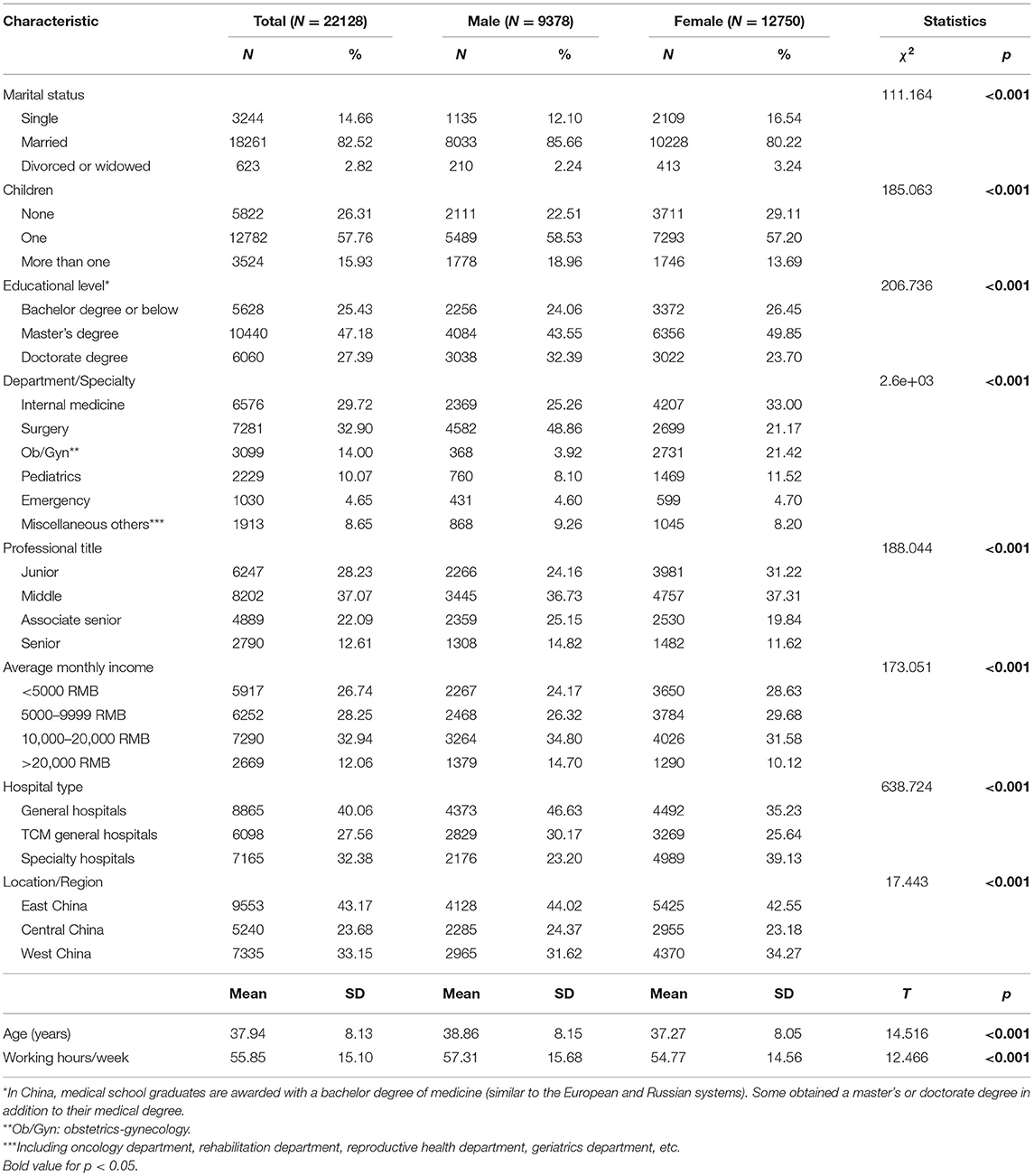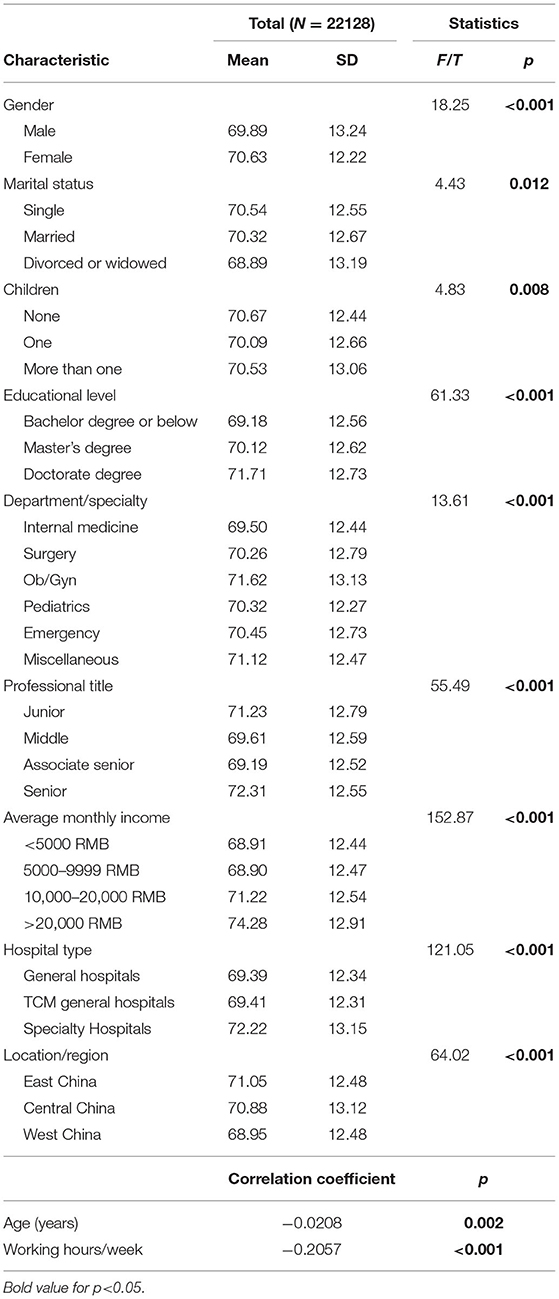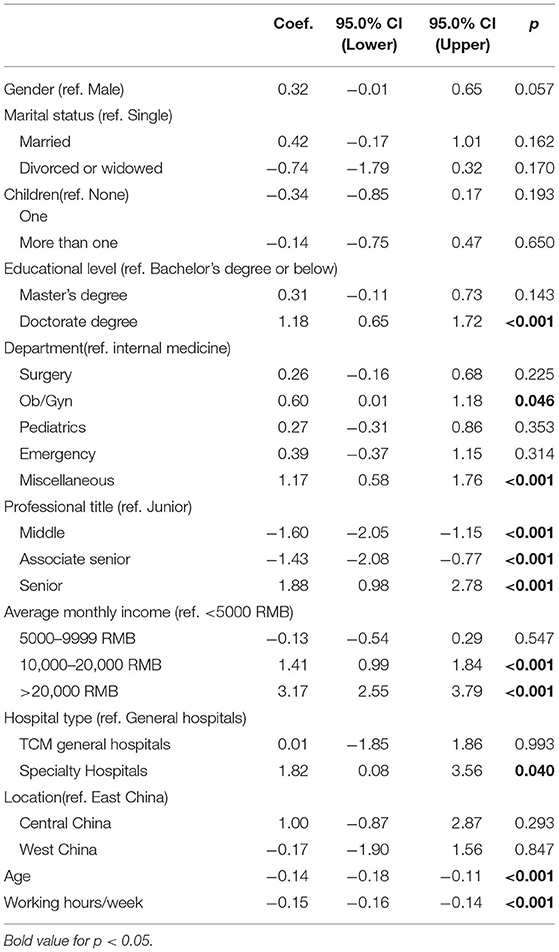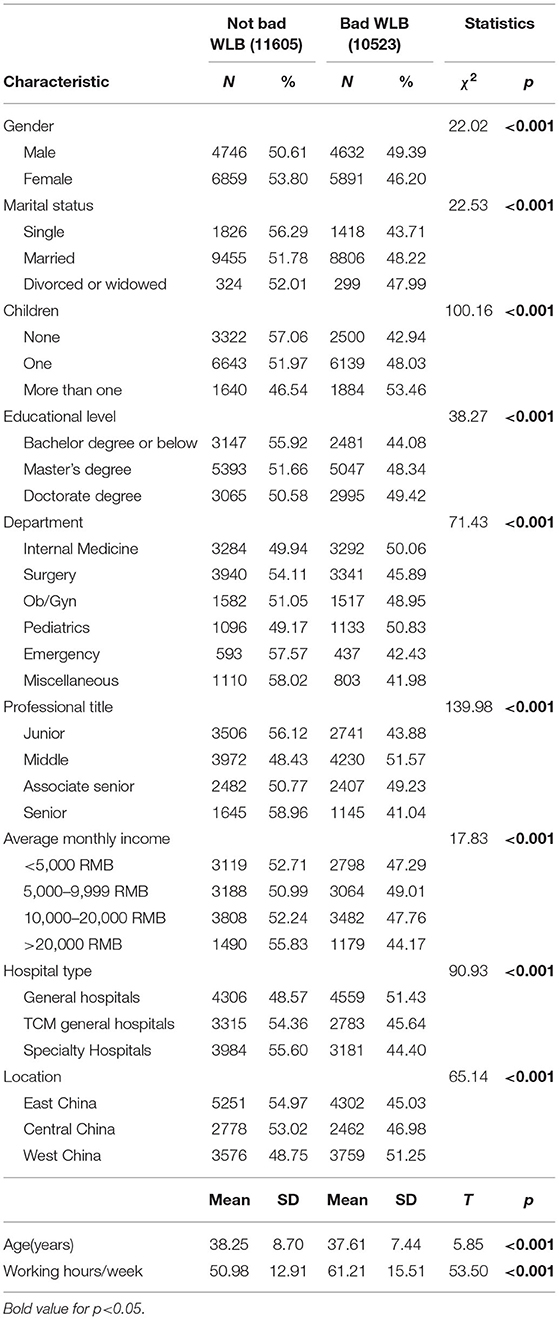- 1School of Health Policy and Management, Chinese Academy of Medical Sciences & Peking Union Medical College, Beijing, China
- 2Chinese Academy of Medical Sciences & Peking Union Medical College, Beijing, China
- 3Institute of Healthy Yangtze River Delta, Shanghai Jiao Tong University, Shanghai, China
- 4Department of Cardiology, Emergency General Hospital, Beijing, China
- 5Department of Psychiatry and Behavioral Sciences, Emory University, Atlanta, GA, United States
- 6Atlanta VA Medical Center, Decatur, Georgia, GA, United States
Background: Gender has been associated with job-related experience, including job satisfaction and work-life balance. This study aimed to identify gender differences in job satisfaction and work-life balance among Chinese physicians in a large, nationally representative sample.
Methods: A national cross-sectional survey was conducted between March 18 and 31, 2019, using an anonymous online questionnaire. The questionnaire included the short-form MSQ (Chinese version) and a work-life balance item. The demographic and job-related factors were also collected.
Findings: In total, 22,128 physicians (9,378 males and 12,750 females) from 144 tertiary public hospitals completed the survey. The overall MSQ score (job satisfaction) was 70.31 ± 12.67, and it was 69.89 ± 13.24 in males, and 70.63 ± 12.22 in females, respectively (p < 0.001). Only 931 (4.21%) physicians were very satisfied with WLB (421 males, 510 females), and 2,534 (11.45%) were rated as satisfied. Age, education, monthly income, working hours, specialty, and professional titles were significantly associated with job satisfaction; while number of children, specialty, professional titles, monthly income, age, working hours were significantly associated with WLB. No significant gender differences were observed in job satisfaction or WLB after controlling confounding factors (both p > 0.05).
Interpretation: While many demographic and work-related factors are significantly associated with job satisfaction and WLB, we found no significant gender differences, which is different from many other studies. To improve Chinese physicians' job satisfaction and work-life balance, interventions should be focused on certain specialties and on other modifiable factors, such as income, working hours.
Introduction
Job satisfaction can be defined as the attitudes resulting from one's job experience (1, 2). Previous studies have identified a series of factors associated with physicians' job satisfaction, such as age, gender, marital status, professional title, and educational background etc (3–9). Many studies have examined gender differences of job satisfaction in physicians. While some did not find significant gender differences (10–15), and a few other studies even found the opposite, that male physician reported higher job satisfaction (16, 17).
Work-life balance (WLB) is a common concept with no universally accepted definition. It can be roughly defined as the state of equilibrium degree of how a person equally prioritizes the demands of his/her career and the needs of his/her personal life, with a minimum role conflict at work and at home life (18). A good WLB improves job satisfaction, psychosocial well-being, and overall quality of life (19, 20). On the contrary, a work-life imbalance (bad WLB) often leads to psychological strain, lower life and job satisfaction, depression, burnout, and family conflict, and other health problems (21–25).
Gender is associated with many job-related factors, and the relationship between gender and WLB has recently attracted much interest. As gender refers to the culturally defined roles and responsibilities in given settings, traditional gender roles prescribe different emphases for men and women: work for men and family responsibility for women (26). Although gender systems could be equitable, gender inequality in WLB have often been reported in past decades. Many studies showed that gender differences existed in job satisfaction with medical practice. In most cultures, especially Asian cultures, female workers are expected to share more household responsibilities than their male counterparts. They are more likely to reach the “glass ceiling” of career (27, 28). A series of studies demonstrated that gender plays a vital role in WLB (29–33).
In the healthcare field, several previous studies investigated gender difference in WLB, but got inconsistent results (34–39). One study showed that WLB varied significantly among healthcare specialties, length of work time and work settings (18). The situation also understandably varies across different cultures, and some believe this situation may be worse in Eastern countries due to the long history of sexism (40). However, there have been few studies examining gender differences in WLB among Chinese physicians. Therefore, this study aimed to investigate gender differences in physicians' job satisfaction and WLB in Chinese tertiary public hospitals.
Data and Methods
Study Design and Samples
The study was a part of a national survey conducted in 2019, the China National Healthcare Improvement Initiative Survey (41). The National Health Commission of China approved and sponsored this survey. The project was completed between March 18 to 31, 2019. We purposely involved 144 tertiary public hospitals in the capital cities of each province in mainland China, including 59 general hospitals, 37 Traditional Chinese Medicine (TCM) hospitals, 33 maternal and children's hospitals, five stomatological hospitals, four cancer hospitals, and six other specialty hospitals. These hospitals accounted for 6.45% of all the tertiary hospitals, delivered 12.28% of the inpatient care among tertiary hospitals, 10.90% of all physicians in tertiary hospitals (42). In the Chinese healthcare system, tertiary hospitals play a critical role.
Based on their employee's ID codes on the hospital staff lists, physicians were sampled through a systematic sampling method in each participating hospital. We invited 170 physicians from each hospital to participate. The survey was conducted anonymously through WeChat, a widely used online social media application in China.
Ethics Statement
The Ethics Committee (IEC) of the Emergency General Hospital in Beijing approved the study protocol. All participated physicians signed the informed consent before they proceeded to respond to the questionnaires. The informed consent statement explained the purpose of the survey, ensured that the data would be de-identified before analysis and that the hospitals' administrators would have no access to their responses.
Measures
The online questionnaire collected their demographic information, including gender, age, marital status, number of children, educational level, department (specialty), professional title, average monthly income, average working hours per week, hospital type, and location (geographical region).
Job satisfaction was measured through the short version of the Minnesota Satisfaction Questionnaire (MSQ) (Chinese version), which has been widely used and has demonstrated good reliability and validity (43, 44). Work-life balance was measured using the following question: “How are you satisfied with the balance of your work and your family?” (30, 36). They were used as the outcome measure in this study.
The items for MSQ and WLB were 5-point Likert scale responses: very dissatisfied-1, dissatisfied-2, neither-3, satisfied-4, and very satisfied-5. The responses for WLB were dichotomized into two groups: Dissatisfied WLB (very dissatisfied/dissatisfied) and non-Dissatisfied WLB (neither/satisfied/very satisfied).
Statistical Analysis
Descriptive analyses were conducted for the variables. Continuous variables were shown with mean and standard deviation, while categorical variables were shown with numbers and percentages. Ages, average working hours per week, MSQ scores were treated as continuous variables. Ages, average working hours between male and female physicians were tested by ANOVA. Chi-square tests were used to examine other characteristics.
As the physicians were nested in 144 hospitals, the null model demonstrated that the intra-class correlation was more than 10%, so we used multi-level linear and logistic regression models to examine gender differences in MSQ and WLB, respectively (45). Participants with missing data were rare (<1%) and were excluded from the analyses.
All statistical analyses were conducted using the statistical software Stata 15 (StataCorpLP, College Station, TX, USA). All statistical analysis tests were two-sided, and the statistical significance was defined as p < 0.05.
Results
Description of Sample Characteristics and Related Factors
In total, 24,480 physicians were invited to participate, and 22,416 responded (response rate = 91.57%). After removing 288 participants with incomplete data, data from 22,128 physicians (22128/22416, 98.72%) were included in the final analysis. Their socio-demographic and job-related characteristics are shown in Table 1. There were 9,378 male (42.4%) and 12,750 (57.6%) female physicians. The average weekly working hours were 55.85 ± 15.10 h in this sample. The gender differences in demographic factors (age, marriage status, number of children, education), work-related factors (specialty, professional title, income, hospital type, working-hours, and regions) were all significant (Table 1).
The MSQ score was 70.31 ± 12.67 overall, and 69.89 ± 13.24 in male physicians, 70.63 ± 12.22 in female physicians, respectively (p < 0.001). Univariate analysis demonstrated that all other demographic factors (age, marriage status, number of children, education) and work-related factors (specialty, professional title, income, hospital type, working-hours, and regions) were significantly associated with MSQ scores (Table 2).
In the multi-level linear regression analysis model, we found that physicians with doctorate degrees, in Ob/Gyn and “Miscellaneous departments” (which included oncology department, rehabilitation department, reproductive department, geriatrics department, etc.), with senior professional titles, with a monthly income of more than 10,000 RMBs, in specialty hospitals, had higher MSQ scores, with middle and associate senior professional titles, elder, longer working hours were significantly associated with lower MSQ scores. Although there was a trend that female physicians had a little higher MSQ scores than males, it was not statistically significant (p = 0.057) (Table 3).
In the whole sample, only 931 (4.21%) physicians were very satisfied with WLB (421 males, 510 females), 2,534 (11.45%) rated as satisfied (1,030 males and 1,504 females), 8,140 (36.79%) rated as neither satisfied nor dissatisfied (3,295 males and 4,845 females), 6,288 (28.42%) as dissatisfied (2,624 males and 3,664 females), 4,235 (19.14%) as very dissatisfied (2,008 males and 2,227 females). In short words, only 15.70% of physicians were satisfied or very satisfied with their WLB.
After regrouping the reported WLB into a categorical variable, 10,523 (47.56%) were classified as dissatisfied with WLB and 11,605 (52.44%) as non-dissatisfied with WLB. Among them, 49.39% of male and 46.20% of female physicians were classified as dissatisfied WLB, respectively (p < 0.001). All other demographic and work-related factors were significantly associated with WLB in univariate analysis (details see Table 4).
In the multi-level logistic regression model, we found physicians with one (OR = 1.52) or more than one child (OR = 1.77), middle (OR = 1.36) or associate senior professional title (OR = 1.35), monthly income of 5,000–9,999 RMBs (OR = 1.10), longer working hours/week (OR = 1.06) were more likely to have dissatisfied WLB. While physicians in surgery (OR = 0.85) or “Miscellaneous departments” (OR = 0.80), older (OR = 0.99) were less likely to have dissatisfied WLB. Similar to the analysis with job satisfaction, we failed to observe significant gender differences in WLB after controlling for confounding factors (Table 5).
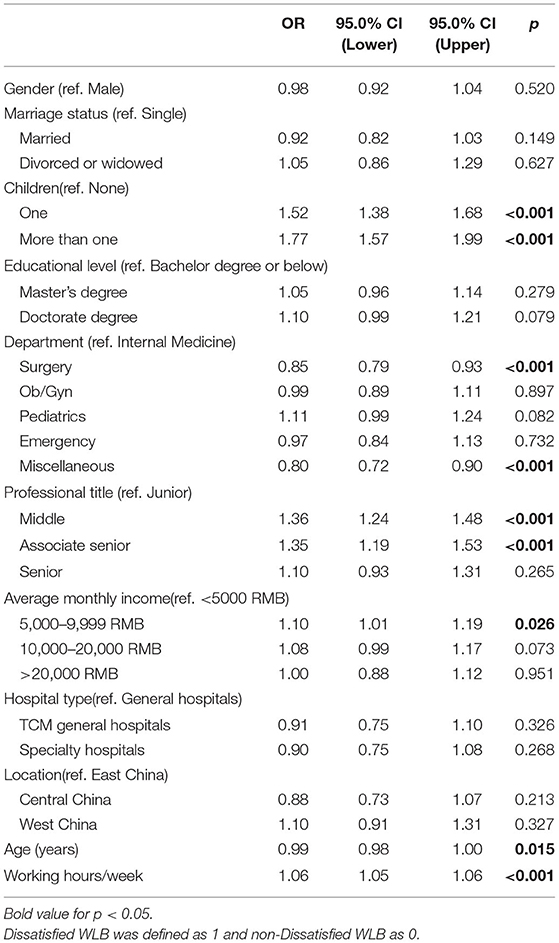
Table 5. Multi-level Logistic regression examining factors associated with WLB (Dissatisfied WLB vs. non-Dissatisfied WLB).
Discussion
To our best knowledge, this study was among the first studies focusing on gender differences in job satisfaction and WLB based on a nationally representative physician sample in China, covering a wide range in terms of specialty, hospital types, and geographical regions. While we replicated some of the findings reported by others, one unique finding is that no significant gender differences were found in physician job satisfaction and WLB.
Gender differences are a longstanding phenomenon and an important research topic, in which job satisfaction and WLB are two aspects that have gained research attention in recent years. Job satisfaction describes the level of contentment and fulfillment that employees derive from their jobs. Studies suggested that different job expectations, values and many other factors may contribute to the differences in job satisfaction between men and women (17). In the healthcare field, studies of WLB have mostly centered on “role” and the conflicts between work and family as the main sources of poor WLB. The society often has double expectations for women, this is particularly true in China, where most people believe in the traditional sex role assignment. On one side, women are expected to perform well in their career; on the other side, they are also expected to be a “good wife and good mother” and take most household responsibilities. Therefore, career women often suffer more conflicts between work and family and bad WLB (Shui et al., 2020). To add to the problem, most career women in China work full time.
Our finding that there was no significant association between gender and job satisfaction is in line with several previous reports involving different samples from several countries. For example, the surveys of 2,584 Canadian physicians (10), of 248 American obstetrician/gynecologists (11), and of other physician samples (12–15), no significant gender differences were found in job satisfaction. In the meantime, some studies have found significant gender differences. For example, Saperstein et al. surveyed 186 Navy family physicians with one self-developed item, and found that males had more positive job satisfaction (16). While in 1,472 doctors from rural areas in West China, the authors reported that female doctors had better job satisfaction than males, based on a self-developed questionnaire (17).
In our study, only 4.21% of the participants were very satisfied with WLB, and 11.45% were satisfied; both were much lower than that reported in other studies. For example, Starmer et al. showed that 17% American pediatricians were very satisfied with their WLB (39); another survey demonstrated that 10.6% US physicians were strongly satisfied and 30.3% satisfied (36); Streu et al. found that 52% U.S. plastic surgeons were satisfied with their WLB (35). The considerable gap suggests much improvement is needed. To improve the status, hospital administrations and policymakers should pay more attention to the job-related risk factors and target risk subgroups, such as surgeons and physicians working in the “miscellaneous departments” (including oncology, reproductive departments, etc.), those with middle or associate senior professional titles, and those with lower-income, and longer working hours.
Furthermore, our finding of no significant gender difference in WLB, from a large sample of Chinese physicians, is also different from most studies in physicians. Literature review shows that four surveys in the U.S. found that female physicians had a significantly lower WLB than male physicians (34–39). Two other U.S. studies found no significant gender difference in physician WLB. In a survey of 127 American faculty surgeons, Baptiste et al. found that there was no significant gender difference in the overall work life balance (mean 2.6 for female vs. 2.9 for male, p = 0.3) (37). Similarly, in a sample of 433 physicians in South Dakota, 54.7% of male physicians and 55.4% female physicians were satisfied with their WLB, without significant gender difference (37). Although no gender differences were found in this study, the moderating role of gender in the relationship between organizational behaviors and outcomes should be examined in the future.
Cultural factors, social policies and role expectations have been found to be associated with work-life balance (46, 47). The fact that we did not observe significant gender differences in this sample could also mean more gender equity in family responsibilities in China, especially among married physicians. As suggested by some authors, the rapid economic growth and social progress have pushed more gender equity in employment opportunities and career development (48, 49).
Several limitations about our study need to be mentioned. First, as in all cross-sectional studies, the causal relationship of different factors cannot be established. Second, the participating hospitals were tertiary public hospitals, which often mean they have more cases and also more resources than lower-level hospitals, so the results may not be generalized to all hospitals. Third, although we have some data about the participants' marital status and number of children, we did not collect other important data on their home or personal life, such as the time they spent taking care of chores or other home responsibilities, time for pleasure and relaxation, and these factors are likely associated with WLB (50). Finally, the WLB in our survey was measured by a single item instead of a standardized instrument, which may be limited in reliability and validity.
Conclusions
In conclusion, while we found that many demographic and job-related factors are significantly associated with job satisfaction and work-life balance, we did not find significant gender differences in either of the assessments between male and female physicians in China, which is different from many other studies. To improve physicians' job satisfaction and WLB in China, interventions should focus on certain specialties and on modifiable factors, such as work hours and income.
Data Availability Statement
The raw data supporting the conclusions of this article will be made available by the authors, without undue reservation.
Ethics Statement
The studies involving human participants were reviewed and approved by The Ethics Committee (IEC) of the Emergency General Hospital in Beijing approved the study protocol. The patients/participants provided their written informed consent to participate in this study.
Author Contributions
DL, YW, FJ, MW, YL, and Y-LT: conceptualization. YW: data curation and investigation. FJ: data analysis. YL: funding acquisition. FJ and Y-LT: methodology. DL: wrote an original draft. DL, YL, and Y-LT: wrote revision & editing. All authors contributed to the article and approved the submitted version.
Funding
The National Health Commission of China funded this project.
Conflict of Interest
The authors declare that the research was conducted in the absence of any commercial or financial relationships that could be construed as a potential conflict of interest.
Acknowledgments
The authors thank all the field survey interviewers for their dedicated fieldwork and physicians who participated in the survey for their time and effort in data collection.
References
2. Judge TA, Weiss HM, Kammeyer-Mueller JD, Hulin CL. Job attitudes, job satisfaction, and job affect: a century of continuity and of change. J Appl Psychol. (2017) 102:356–74. doi: 10.1037/apl0000181
3. Lu Y, Hu XM, Huang XL, Zhuang XD, Guo P, Feng LF, et al. Job satisfaction and associated factors among healthcare staff: a cross-sectional study in Guangdong Province, China. BMJ Open. (2016) 6:e011388. doi: 10.1136/bmjopen-2016-011388
4. Sun J, Ma J, Hu G, Zhao Q, Yuan C, Si W, et al. Welfare, wellness, and job satisfaction of Chinese physicians: a national survey of public tertiary hospitals in China. Int J Health Plann Manage. (2017) 32:270–284. doi: 10.1002/hpm.2420
5. Tarcan M, Hikmet N, Schooley B, Top M, Tarcan GY. An analysis of the relationship between burnout, socio-demographic and workplace factors and job satisfaction among emergency department health professionals. Appl Nurs Res. (2017) 34:40–7. doi: 10.1016/j.apnr.2017.02.011
6. Jiang F, Hu L, Rakofsky J, Liu T, Wu S, Zhao P, et al. Sociodemographic characteristics and job satisfaction of psychiatrists in China: results from the first nationwide survey. Psychiatr Serv. (2018) 69:1245–51. doi: 10.1176/appi.ps.201800197
7. Jiang F, Zhou H, Hu L, Rakofsky J, Liu T, Wu S, et al. Psychiatry residents in china: socio-demographic characteristics, career satisfaction, related factors. Front Psychiatry. (2019) 10:177. doi: 10.3389/fpsyt.2019.00177
8. Raphael MJ, Fundytus A, Hopman WM, Vanderpuye V, Seruga B, Lopes G, et al. Medical oncology job satisfaction: results of a global survey. Semin Oncol. (2019) 46:73–82. doi: 10.1053/j.seminoncol.2018.12.006
9. Kabbash IA, El-Sallamy RM, Abdo SAE, Atalla AO. Job satisfaction among physicians in secondary and tertiary medical care levels. Environ Sci Pollut Res Int. (2020) 27:37565–571. doi: 10.1007/s11356-020-08506-9
10. Richardsen AM, Burke RJ. Occupational stress and job satisfaction among physicians: sex differences. Soc Sci Med. (1991) 33:1179–87. doi: 10.1016/0277-9536(91)90234-4
11. Emmons SL, Nichols M, Schulkin J, James KE, Cain JM. The influence of physician gender on practice satisfaction among obstetrician gynecologists. Am J Obstet Gynecol. (2006) 194:1728–38. doi: 10.1016/j.ajog.2006.03.012
12. Aasland OG, Rosta J, Nylenna M. Healthcare reforms and job satisfaction among doctors in Norway. Scand J Public Health. (2010) 38:253–8. doi: 10.1177/1403494810364559
13. Goetz K, Jossen M, Szecsenyi J, Rosemann T, Hahn K, Hess S. Job satisfaction of primary care physicians in Switzerland: an observational study. Fam Pract. (2016) 33:498–503. doi: 10.1093/fampra/cmw047
14. Haller G, Delhumeau C, Mamie C, Zoccatelli D, Clergue F. Gender difference in career advancement and job satisfaction in anaesthesia: a cross-sectional study. Eur J Anaesthesiol. (2016) 33:588–90. doi: 10.1097/EJA.0000000000000471
15. Spencer ES, Deal AM, Pruthi NR, Gonzalez CM, Kirby EW, Langston J, et al. Gender differences in compensation, job satisfaction and other practice patterns in urology. J Urol. (2016) 195:450–5. doi: 10.1016/j.juro.2015.08.100
16. Saperstein AK, Viera AJ, Firnhaber GC. Mentorship and job satisfaction among navy family physicians. Mil Med. (2012) 177:883–8. doi: 10.7205/MILMED-D-11-00362
17. Miao Y, Li L, Bian Y. Gender differences in job quality and job satisfaction among doctors in rural western China. BMC Health Serv Res. (2017) 17:848. doi: 10.1186/s12913-017-2786-y
18. Schwartz SP, Adair KC, Bae J, Rehder KJ, Shanafelt TD, Profit J, et al. Work-life balance behaviours cluster in work settings and relate to burnout and safety culture: a cross-sectional survey analysis. BMJ Qual Saf. (2019) 28:142–150. doi: 10.1136/bmjqs-2018-007933
19. Greenhaus JH, Collins KM, Shaw JD. The relation between work–family balance and quality of life. J Vocat Behav. (2003) 63:510–31. doi: 10.1016/S0001-8791(02)00042-8
20. Van Rijswijk K, Bekker MH, Rutte CG, Croon MA. The relationships among part-time work, work-family interference, and well-being. J Occup Health Psychol. (2004) 9:286–95. doi: 10.1037/1076-8998.9.4.286
21. Adams GA, Jex SM. Relationships between time management, control, work-family conflict, and strain. J Occup Health Psychol. (1999) 4:72–7. doi: 10.1037/1076-8998.4.1.72
22. Grzywacz JG, Bass BL. Work, family, and mental health: testing different models of work-family fit. J Marriage Fam. (2003) 65:248–61. doi: 10.1111/j.1741-3737.2003.00248.x
23. Peeters MC, Montgomery AJ, Bakker AB, Schaufeli WB. Balancing work and home: how job and home demands are related to burnout. Int J Stress Manage. (2005) 12:43–61. doi: 10.1037/1072-5245.12.1.43
24. Berkman LF, Buxton O, Ertel K, Okechukwu C. Managers' practices related to work-family balance predict employee cardiovascular risk and sleep duration in extended care settings. J Occup Health Psychol. (2010) 15:316–29. doi: 10.1037/a0019721
25. Witzig TE, Smith SM. Work-life balance solutions for physicians-it's all about you, your work, and others. Mayo Clin Proc. (2019) 94:573–6. doi: 10.1016/j.mayocp.2018.11.021
26. Heise L, Greene ME, Opper N, Stavropoulou M, Harper C, Nascimento M, et al. Gender inequality and restrictive gender norms: framing the challenges to health. Lancet. (2019) 393:2440–54. doi: 10.1016/S0140-6736(19)30652-X
27. Angell M. Shattering the glass ceiling. JAMA Intern Med. (2014) 174:635–6. doi: 10.1001/jamainternmed.2013.13918
28. Jolly S, Griffith KA, Decastro R, Stewart A, Ubel P, Jagsi R. Gender differences in time spent on parenting and domestic responsibilities by high-achieving young physician-researchers. Ann Intern Med. (2014) 160:344–53. doi: 10.7326/M13-0974
29. Chandra V. Work–life balance: eastern and western perspectives. Int J Hum Resour Manage. (2012) 23:1040–56. doi: 10.1080/09585192.2012.651339
30. Lunau T, Bambra C, Eikemo TA, Van Der Wel KA, Dragano N. A balancing act? Work-life balance, health and well-being in European welfare states. Eur J Public Health. (2014) 24:422–7. doi: 10.1093/eurpub/cku010
31. Cuéllar-Molina D, García-Cabrera AM, Lucia-Casademunt AM. Is the institutional environment a challenge for the well-being of female managers in Europe? The mediating effect of work−life balance and role clarity practices in the workplace. Int J Environ Res Public Health. (2018) 15:1813. doi: 10.3390/ijerph15091813
32. Sullivan O. Gender inequality in work-family balance. Nat Hum Behav. (2019) 3:201–203. doi: 10.1038/s41562-019-0536-3
33. Chung H, Van Der Lippe T. Flexible working, work-life balance, and gender equality: introduction. Soc Indic Res. (2020) 151:365–81. doi: 10.1007/s11205-018-2025-x
34. Keeton K, Fenner DE, Johnson TR, Hayward RA. Predictors of physician career satisfaction, work-life balance, and burnout. Obstet Gynecol. (2007) 109:949–55. doi: 10.1097/01.AOG.0000258299.45979.37
35. Streu R, Mcgrath MH, Gay A, Salem B, Abrahamse P, Alderman AK. Plastic surgeons' satisfaction with work-life balance: results from a national survey. Plast Reconstr Surg. (2011) 127:1713–9. doi: 10.1097/PRS.0b013e318208d1b3
36. Shanafelt TD, Hasan O, Dyrbye LN, Sinsky C, Satele D, Sloan J, et al. Changes in burnout and satisfaction with work-life balance in physicians and the general US working population between 2011 and 2014. Mayo Clin Proc. (2015) 90:1600–13. doi: 10.1016/j.mayocp.2015.08.023
37. Baptiste D, Fecher AM, Dolejs SC, Yoder J, Schmidt CM, Couch ME, et al. Gender differences in academic surgery, work-life balance, and satisfaction. J Surg Res. (2017) 218:99–107. doi: 10.1016/j.jss.2017.05.075
38. Clemen NM, Blacker BC, Floen MJ, Schweinle WE, Huber JN. Work-life balance in women physicians in south dakota: results of a state-wide assessment survey. S D Med. (2018) 71:550–8.
39. Starmer AJ, Frintner MP, Matos K, Somberg C, Freed G, Byrne BJ. Gender discrepancies related to pediatrician work-life balance and household responsibilities. Pediatrics. (2019) 144:e20182926. doi: 10.1542/peds.2018-2926
40. Jang ES, Park SM, Park YS, Lee JC, Kim N. Work-life conflict and its health effects on korean gastroenterologists according to age and sex. Dig Dis Sci. (2020) 65:86–95. doi: 10.1007/s10620-019-05842-w
41. Zhou H, Han X, Zhang J, Sun J, Hu L, Hu G, et al. Job satisfaction and associated factors among medical staff in tertiary public hospitals: results from a national cross-sectional survey in China. Int J Environ Res Public Health. (2018) 15:1528. doi: 10.3390/ijerph15071528
42. National Health Commission of the People's Republic of China. China Health Statistical Yearbook. Beijing: Press of Peking Union Medical College (2019).
43. Liu ZY, Wei WH, Lu W, Cui HZ, Li YY, Zhang FL. The relationship among job satisfaction, work engagement and organizational citizenship behavior of nurses. Chin J Behav Med Brain Sci. (2017) 26:747–750. doi: 10.3760/cma.j.issn.1674-6554.2017.08.016
44. Wang J, Zhao Q, Yuan L, Pan ZG. Survey on work satisfaction among general practitioners in Shanghai. Chin J Gen Practitioners. (2017) 16:921–5. doi: 10.3760/cma.j.issn.1671-7368.2017.12.005
45. Goldstein H. Mutilevel Statistical Models. 4th ed. Chichester: Wiley (2011). doi: 10.1002/9780470973394
46. Xiao Y, Cooke FL. Work–life balance in China? Social policy, employer strategy and individual coping mechanisms. Asia Pac J Hum Resour. (2012) 50:6–22. doi: 10.1111/j.1744-7941.2011.00005.x
47. Shockley K, Shen W, Johnson R. The Cambridge Handbook of the Global Work-Family Interface. Cambridge: Cambridge University Press (2018). doi: 10.1017/9781108235556
48. Zhou Y. The dual demands: gender equity and fertility intentions after the one-child policy. J Contemp China. (2018) 28:367–84. doi: 10.1080/10670564.2018.1542219
49. Lu Y, Zhang Y, Cao X, Wang C, Wang Y, Zhang M, et al. Forty years of reform and opening up: China's progress toward a sustainable path. Sci Adv. (2019) 5:eaau9413. doi: 10.1126/sciadv.aau9413
Keywords: job satisfaction, work-life balance, gender difference, hospitals, China
Citation: Liu D, Wu Y, Jiang F, Wang M, Liu Y and Tang Y-L (2021) Gender Differences in Job Satisfaction and Work-Life Balance Among Chinese Physicians in Tertiary Public Hospitals. Front. Public Health 9:635260. doi: 10.3389/fpubh.2021.635260
Received: 30 November 2020; Accepted: 15 April 2021;
Published: 10 May 2021.
Edited by:
Tao Sun, Hangzhou Normal University, ChinaReviewed by:
Hannah Diab, The University of Jordan, JordanJuan Gómez-Salgado, University of Huelva, Spain
Li Liu, China Medical University, China
Copyright © 2021 Liu, Wu, Jiang, Wang, Liu and Tang. This is an open-access article distributed under the terms of the Creative Commons Attribution License (CC BY). The use, distribution or reproduction in other forums is permitted, provided the original author(s) and the copyright owner(s) are credited and that the original publication in this journal is cited, in accordance with accepted academic practice. No use, distribution or reproduction is permitted which does not comply with these terms.
*Correspondence: Yuanli Liu, bGl1eWxfZnBvQDEyNi5jb20=
 Dan Liu1
Dan Liu1 Feng Jiang
Feng Jiang Yuanli Liu
Yuanli Liu Yi-Lang Tang
Yi-Lang Tang